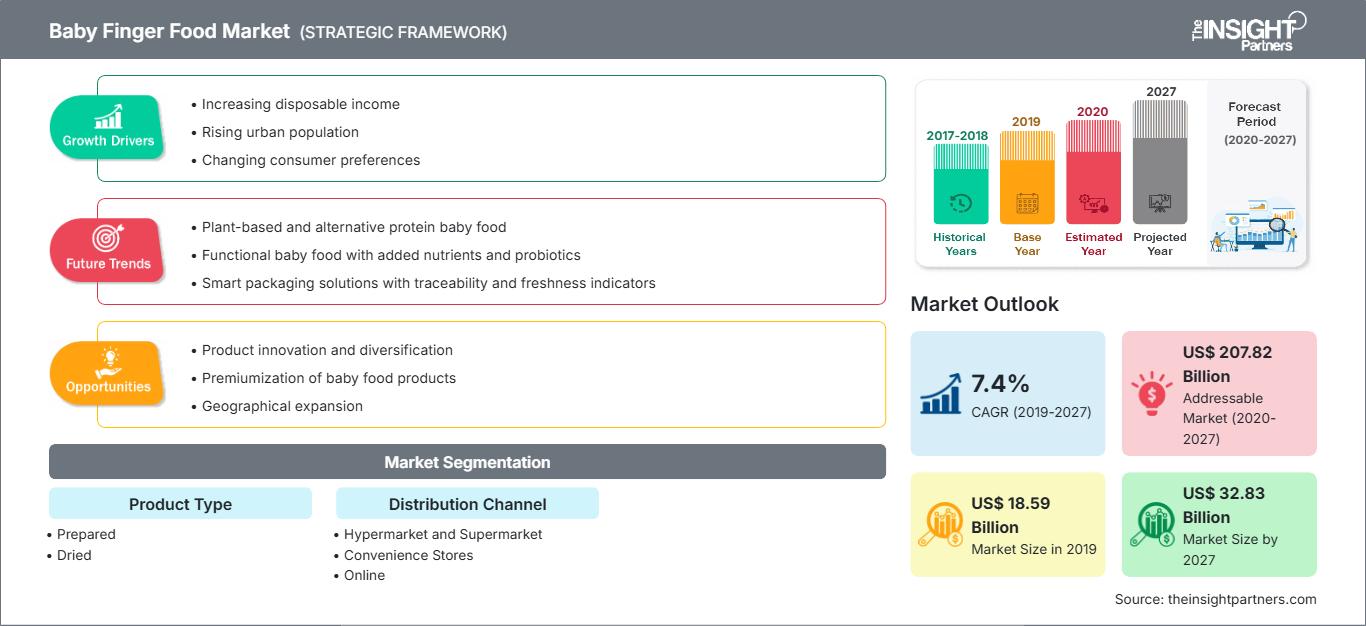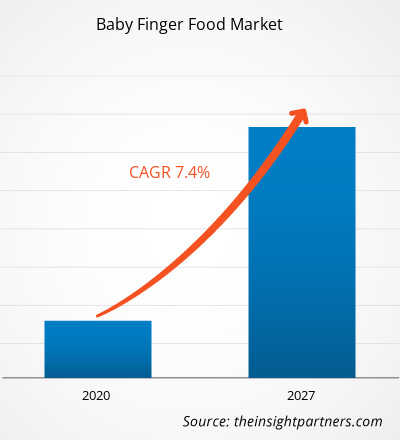Der Markt für Baby-Fingerfood wurde 2019 auf 18.589,43 Millionen US-Dollar geschätzt und soll bis 2027 32.825,92 Millionen US-Dollar erreichen; von 2020 bis 2027 wird ein CAGR-Wachstum von 7,4 % erwartet.
Die Nachfrage nach und die Beliebtheit von Baby-Fingerfood steigen rasant. Diese Lebensmittel bieten Babys leckeres und abwechslungsreiches Fingerfood. Da es diese Lebensmittel in verschiedenen Geschmacksrichtungen gibt, freuen sich Babys immer mehr darüber. Der Markt für Baby-Fingerfood erfährt einen enormen Aufschwung durch das zunehmende Bewusstsein für die Rolle von Fingerfood bei der Deckung des Ernährungsbedarfs von Säuglingen und Kleinkindern. Darüber hinaus treiben die steigende Geburtenrate, attraktive und sichere Verpackungen sowie Produktinnovationen die Nachfrage nach Baby-Fingerfood an.
Der asiatisch-pazifische Raum hat sich aufgrund des zunehmenden Fokus auf Gesundheit und der steigenden Nachfrage nach zubereitetem Baby-Fingerfood zu einem bedeutenden Markt für Baby-Fingerfood entwickelt. Der Anstieg der Säuglingsrate, die steigenden Verbraucherausgaben für Babynahrung und die wachsende Zahl von Supermärkten und Verbrauchermärkten im Land haben ebenfalls zum Geschäftswachstum beigetragen. Der Markt für Baby-Fingerfood im asiatisch-pazifischen Raum wird durch die steigende Zahl berufstätiger Frauen in asiatischen Ländern angetrieben. Der Wandel der Erwerbsbevölkerung fördert das Wachstum von Baby-Fingerfood im asiatisch-pazifischen Raum zusätzlich. Der Anstieg des verfügbaren Einkommens in Verbindung mit einem Paradigmenwechsel hin zum Konsum gesundheitsfördernder und praktischer Babynahrung treibt das Wachstum von Baby-Fingerfood in der Region voran. Zudem bietet die wachsende Nachfrage der Babynahrungsindustrie lukrative Möglichkeiten für die Akteure auf dem Markt für Baby-Fingerfood.
Die COVID-19-Pandemie begann im Dezember 2019 in Wuhan, China, und hat sich seitdem rasant weltweit verbreitet. Im September 2020 gehörten die USA, Brasilien, Indien, Russland, Südafrika, Mexiko und das Vereinigte Königreich zu den am stärksten betroffenen Ländern hinsichtlich bestätigter Fälle und gemeldeter Todesfälle. Die COVID-19-Pandemie hat aufgrund von Lockdowns, Reiseverboten und Betriebsschließungen die Wirtschaft und Industrie in verschiedenen Ländern stark beeinträchtigt. Die Lebensmittel- und Getränkeindustrie ist eine der wichtigsten Branchen, die infolge des Ausbruchs mit schwerwiegenden Störungen wie Büro- und Fabrikschließungen sowie Lieferkettenunterbrechungen konfrontiert ist.
Passen Sie diesen Bericht Ihren Anforderungen an
Sie erhalten kostenlos Anpassungen an jedem Bericht, einschließlich Teilen dieses Berichts oder einer Analyse auf Länderebene, eines Excel-Datenpakets sowie tolle Angebote und Rabatte für Start-ups und Universitäten.
Baby Fingerfood Markt: Strategische Einblicke

-
Holen Sie sich die wichtigsten Markttrends aus diesem Bericht.Dieses KOSTENLOSE Beispiel umfasst Datenanalysen, die von Markttrends bis hin zu Schätzungen und Prognosen reichen.
Bio-Fingerfood für Babys wird aus Obst und Gemüse hergestellt, das ohne den Einsatz von Kunstdünger oder schädlichen Chemikalien angebaut wird. Bio-Fingerfood erfreut sich angesichts alarmierender Gesundheitsprobleme und des zunehmenden Fokus auf eine gesunde Lebensweise zunehmender Beliebtheit. Bio-Fingerfood für Babys behält wichtige Nährstoffe besser. Die zunehmende Verwendung von Obst und Gemüse aus biologischem Anbau bei der Zubereitung von Fingerfood dürfte das Marktwachstum fördern. Unternehmen wie die HiPP GmbH & Co. Vertrieb KG, The Hain Celestial Group, Inc. und andere vertreiben Bio-Fingerfood für Babys weltweit. Neben der steigenden Nachfrage der Bevölkerung nach gesünderen Lebensmitteln hat auch das steigende verfügbare Einkommen die Nachfrage nach Bio-Fingerfood für Babys angekurbelt. Insbesondere die etablierten Länder verzeichnen ein massives Wachstum der Nachfrage nach Bio-Lebensmitteln.
Produkttyp-Einblicke
Basierend auf dem Produkttyp ist der Markt für Fingerfood für Babys in zubereitete, getrocknete und sonstige Produkte unterteilt. Das Segment Fertiggerichte führte den Markt für Baby-Fingerfood mit dem höchsten Marktanteil im Jahr 2019 an. Fertiggerichte für Baby-Fingerfood sind servierfertige und praktische Nahrungsmittel. Diese Art von Produkten muss nicht weiter gekocht werden und kann als Frischkost direkt von Babys verzehrt werden. Die schnelle Urbanisierung und der Wandel der Erwerbsbevölkerung haben die Annahme eines bequemen Lebensstils gefördert, wodurch Fertiggerichte für Baby-Fingerfood gefragter geworden sind. Fertiggerichte sind servierfertig und essbar; daher haben sie weltweit Aufmerksamkeit erregt. Es umfasst hauptsächlich süße und herzhafte Baby-Fingerfood-Artikel wie Puffs, Kekse, Porridge, Pürees, Kürbis und andere Lebensmittel, die sofort verzehrt werden können. Dieses Segment wird aufgrund der steigenden Zahl berufstätiger Frauen in den Schwellenländern weltweit verstärkt wachsen. Aufgrund der steigenden Nachfrage nach nahrhaften und praktischen Babynahrungsprodukten wird für die Kategorie Fertignahrung für den Prognosezeitraum die höchste Wachstumsrate erwartet.
Einblicke in Vertriebskanäle
Basierend auf den Vertriebskanälen ist der Markt für Baby-Fingerfood in Hypermärkte und Supermärkte, Convenience Stores, Online-Shops und andere segmentiert. Das Online-Segment wird im Prognosezeitraum voraussichtlich das am schnellsten wachsende Segment im Markt für Baby-Fingerfood sein. Die Online-Portale haben zum Wachstum und zur Expansion des Marktes für Baby-Fingerfood beigetragen. Die zunehmende Nutzung von Mobiltelefonen, Computern und Laptops hat das Wachstum der digitalen Kanäle in Bezug auf Stärke und Volumen gefördert. Jeder Hersteller möchte seine Produkte online verkaufen, da dies die Betriebskosten senkt und ihm hilft, die Zielgruppe zu erreichen. Dies hilft auch, die Kundenbasis zu vergrößern und seine Produkte zu verkaufen. Darüber hinaus bietet Online-Marketing für Verbraucher zusätzliche Vorteile wie Lieferung nach Hause, vielfältige Zahlungsoptionen sowie attraktive Rabatte und Angebote, die für die Kunden praktisch sind. Viele Verbraucher entscheiden sich für Online-Shopping, da es im Vergleich zu anderen Vertriebskanälen Zeit, Geld und Aufwand spart. Außerdem bieten diese Portale detaillierte Produktinformationen wie Produktbeschreibungen, Nutzerrezensionen, Anwendungen und Bedienungsanleitungen, sodass Käufer verschiedene Produkte auf einen Blick vergleichen und die richtige Produktauswahl treffen können. Funktionen wie 24/7-Verfügbarkeit, einfacher Zugang, sichere Zahlungsoptionen, schneller Service und Lieferung nach Hause haben Verbraucher dazu bewogen, Baby-Fingerfood online zu kaufen. Die zunehmende Verbreitung von Internet und Smartphones hat es Verbrauchern ermöglicht, verschiedene E-Commerce-Portale zu erkunden und Produkte des täglichen Bedarfs online zu kaufen. Das Online-Portal mit seiner ansprechenden Benutzeroberfläche bietet Komfort, eine große Produktpalette sowie Rabatte und Angebote, die Verbraucher anziehen. Der Komfort, die Verfügbarkeit einer großen Produktpalette und das Zeitmanagement von Online-Shops tragen dazu bei, dass Online-Kanäle den Umsatz im Bereich Baby-Fingerfood fördern.
Zu den wichtigsten Marktteilnehmern gehören Kraft-Heinz, Inc., The Hain Celestial Group, Inc., HiPP GmbH & Co. Vertrieb KG, Lotus Bakeries Corporate; Hero Group; Little Dish; Nestlé SA; Annabel Karmel Group Holdings Limited; Piccolo; und Dana Dairy Group. Wichtige Akteure auf dem Markt für Baby-Fingerfood konzentrieren sich auf Strategien wie Fusionen und Übernahmen sowie Produkteinführungen, um die geografische Präsenz und die Kundenbasis weltweit zu vergrößern.
Markt für Baby-Fingerfood
Baby-Fingerfood-MarktDie Analysten von The Insight Partners haben die regionalen Trends und Faktoren, die den Markt für Baby-Fingerfood im Prognosezeitraum beeinflussen, ausführlich erläutert. In diesem Abschnitt werden auch die Marktsegmente und die geografische Verteilung von Baby-Fingerfood in Nordamerika, Europa, dem asiatisch-pazifischen Raum, dem Nahen Osten und Afrika sowie Süd- und Mittelamerika erläutert.Umfang des Marktberichts über Baby-Fingerfood
| Berichtsattribut | Einzelheiten |
|---|---|
| Marktgröße in 2019 | US$ 18.59 Billion |
| Marktgröße nach 2027 | US$ 32.83 Billion |
| Globale CAGR (2019 - 2027) | 7.4% |
| Historische Daten | 2017-2018 |
| Prognosezeitraum | 2020-2027 |
| Abgedeckte Segmente |
By Produkttyp
|
| Abgedeckte Regionen und Länder |
Nordamerika
|
| Marktführer und wichtige Unternehmensprofile |
|
Dichte der Marktteilnehmer für Baby-Fingerfood: Verständnis ihrer Auswirkungen auf die Geschäftsdynamik
Der Markt für Baby-Fingerfood wächst rasant. Die steigende Nachfrage der Endverbraucher ist auf Faktoren wie veränderte Verbraucherpräferenzen, technologische Fortschritte und ein stärkeres Bewusstsein für die Produktvorteile zurückzuführen. Mit der steigenden Nachfrage erweitern Unternehmen ihr Angebot, entwickeln Innovationen, um den Bedürfnissen der Verbraucher gerecht zu werden, und nutzen neue Trends, was das Marktwachstum weiter ankurbelt.

- Holen Sie sich die Baby Fingerfood Markt Übersicht der wichtigsten Akteure
- Fortschreitende Branchentrends im globalen Markt für Baby-Fingerfood, um Akteuren bei der Entwicklung effektiver langfristiger Strategien zu helfen
- Geschäftswachstumsstrategien in entwickelten und sich entwickelnden Märkten
- Quantitative Analyse des globalen Marktes für Baby-Fingerfood von 2017 bis 2027
- Schätzung der Nachfrage nach Baby-Fingerfood in verschiedenen Branchen
- PEST-Analyse zur Veranschaulichung der Wirksamkeit von in der Branche tätigen Käufern und Lieferanten zur Vorhersage des Marktwachstums
- Jüngste Entwicklungen zum Verständnis des Wettbewerbsmarktszenarios und der Nachfrage nach Baby-Fingerfood
- Markttrends und -aussichten in Verbindung mit Faktoren, die das Wachstum des Marktes für Baby-Fingerfood fördern und hemmen
- Entscheidungsprozess durch das Verständnis von Strategien, die das kommerzielle Interesse im Hinblick auf das Wachstum des globalen Marktes für Baby-Fingerfood untermauern
- Marktgröße für Baby-Fingerfood an verschiedenen Marktknotenpunkten
- Detaillierte Übersicht und Segmentierung des globalen Marktes für Baby-Fingerfood sowie dessen Dynamik in der Branche
- Marktgröße für Baby-Fingerfood in verschiedenen Regionen mit vielversprechenden Wachstumschancen
Globaler Markt für Baby-Fingerfood nach Produkttyp
- Zubereitet
- Getrocknet
- Sonstige
Globaler Markt für Baby-Fingerfood nach Vertriebskanal
- Hypermärkte und Supermärkte
- Convenience Stores
- Online
- Sonstige
Unternehmensprofile
- Hero Group
- Little Dish
- Nestlé, SA
- Kraft-Heinz, Inc.
- The Hain Celestial Group, Inc.
- Annabel Karmel Group Holdings Limited
- HiPP GmbH & Co. Vertrieb KG
- Piccolo
- Lotus Bakeries Corporate
- Dana Dairy Group
- Historische Analyse (2 Jahre), Basisjahr, Prognose (7 Jahre) mit CAGR
- PEST- und SWOT-Analyse
- Marktgröße Wert/Volumen – Global, Regional, Land
- Branchen- und Wettbewerbslandschaft
- Excel-Datensatz
Aktuelle Berichte
Verwandte Berichte
Erfahrungsberichte
Grund zum Kauf
- Fundierte Entscheidungsfindung
- Marktdynamik verstehen
- Wettbewerbsanalyse
- Kundeneinblicke
- Marktprognosen
- Risikominimierung
- Strategische Planung
- Investitionsbegründung
- Identifizierung neuer Märkte
- Verbesserung von Marketingstrategien
- Steigerung der Betriebseffizienz
- Anpassung an regulatorische Trends






















 Kostenlose Probe anfordern für - Baby Fingerfood Markt
Kostenlose Probe anfordern für - Baby Fingerfood Markt